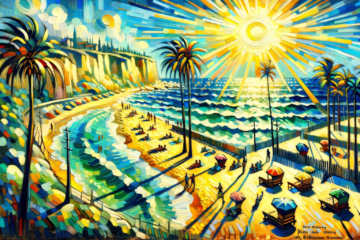What is the secret behind so many foreigners moving to Serbia recently? In this article, we’ll uncover the hidden reasons why people seem to be flocking to this Balkan powerhouse.
Furthermore, we’ll answer questions you have, such as “How can you stay long-term in Serbia,” “What is it like for foreigners” and “What are the best places for foreigners to live in Serbia?”
Why Are So Many Foreigners Moving to Serbia?
- Affordable lifestyle
- Remote work-accommodating
- Great freedom
- Serbia is the only country in Europe operating flights to Russia
- A good level of safety
- The art and music scene
- English speaking and welcoming population
For a European country, Serbia is considered to be pleasantly affordable. And considering its central location and proximity to other European capitals, Belgrade is the first choice for many choosing to relocate to Eastern Europe. But apart from those factors, what makes them decide to settle in the country long-term? Keep reading to learn some must-know facts about why so many foreigners are moving to Serbia.
1) Serbia’s affordable lifestyle
The level of affordability is a big factor when deciding to do anything in life, yet alone move to another country, thus the big decision of living abroad has to pass the affordability test!
Like other places, inflation is hitting Serbia too, and the prices of groceries, rent and utilities are rising. However, the cost of living in Serbia is still very attractive, especially for residents with foreign income. On that subject, did you know it is possible to live in Serbia for $1000 a month?
This benefit seen in the cost of living in Serbia is definitely a big factor for making foreigners relocate to the country.
2) Great remote working communities in Serbia
As mentioned above, the cost of living in Serbia and paying for rent, utilities, groceries and leisure activities, is remarkably lower than most European countries. Some might be shocked to find out that living in Serbia is 128% cheaper than living in the US.
Now imagine a remote worker with foreign income in Serbia. With greater purchasing power, expats can create a much more comfortable lifestyle than in their home countries! Moreover, they can find communities of like-minded people to exchange ideas, cooperate on projects and feel more welcomed as remote workers in Serbia.
3) Freedom
Serbia, and its largest cities Belgrade, Novi Sad and Niš, truly offer much greater freedom than other European countries. Even though its bureaucratic system can be slow and not fully regulated, that soft chaos is exactly what creates the feeling of freedom for many locals and foreigners relocating to Serbia.
Why is there a greater sense of freedom in Serbia?
- It’s safe to walk around at night in any area.
- You can express yourself freely.
- You can wear anything you like.
- LGBTQ+ members are mostly accepted.
- There are opportunities to develop yourself.
- The country offers entrepreneurial and business opportunities.
On a more direct note, factors that affect the level of our freedom and safety can be easily overlooked if we don’t consider the people affected by war or restrictive political regimes. That brings us to the next factor contributing to Serbia’s popularity with foreigners.
4) Serbia is the only country in Europe operating flights to Russia
Not only was Serbia the only country operating flights to Russia in 2022, but it also doubled its flights in March of the same year. While there was a ban in place in countries that are members of the European Union, Serbia’s neutral stance allowed flights from Russia.
This allowed Ukrainian and Russian citizens to relocate to Serbia all year long. Some used the country to bypass other European regions, while others decided to stay long-term. According to DW and Serbian Monitor, 30,000 to 50,000 Russian citizens relocated to Serbia in 2022, opening more than 1,000 businesses in the country.
5) Is it safe for foreigners in Serbia? …Yes!
Serbia has been out of war since the 90s, and ever since the 1999 bombing, and the country has been absolutely peaceful since then. The absence of war and conflict is the fundamental layer of safety. Other threats to travellers aren’t as prevalent in Serbia, such as the following:
- There’s low rates of pickpocketing, so long as you’re not an easy target.
- There are scam taxi drivers, but they’re easy to avoid with straightforward rules, such as don’t get into unmarked taxis and use apps like CarGo or Yandex Taxi.
- Serbia has no bad neighborhoods that you must avoid, but general awareness when exploring the city at night is important.
- The country has freedom of expression, however the media has some censorship. But citizens are allowed to be open about their opinions and attitudes, and they expect the same from you.
6) The art and music scene
Why do we consider this a factor that attracts people to relocate to Serbia? Simply because access to art and music venues creates a specific atmosphere that seeps through the whole society. It changes people’s mindsets and creates a safe space for artists around the world to express themselves and work on their craft.
But can one live off of creating art in Serbia? No. Like in many places, it’s nearly impossible to support yourself from art alone. However, Serbia is a solid playground for many forms of art, and collaborating is easy and pleasurable since there are many creative people eager to connect.
Serbia has good art programs at schools and festivals, as well as individuals and organizations supporting artists.
7) Proficient English-speaking and welcoming locals
Locals in the whole of Serbia speak English well, and this is the case outside of the bigger cities too. Most locals can even communicate in a third language to a certain degree. Alongside the ability to speak English, Serbian people are very friendly, talkative and spontaneous. It is common for locals to strike up conversations with strangers while helping them with directions, so don’t be surprised if this happens to you.
This open, communicative and social vibe of the country is precisely why Serbia is attracting foreigners. The country gives visitors that feeling of all doors being open to them. Without a language barrier, getting settled, finding a job (if you don’t already have one) and making friends is a breeze.
How to relocate to Serbia and stay long-term
Going to Serbia on a tourist visa allows you 90 days in the country, however this is a short period. It will require either going on border runs, relocating to a different place for three months or struggling with settling down. For that reason, it is good to get familiar with different ways of staying in Serbia under temporary residency. After 5 years of temporary residency, foreigners can apply for permanent residency in Serbia.
Some options for staying long-term in Serbia are:
- Extending your tourist visa
- Opening a company
- Buying property
- Becoming employed by a Serbian company
- Bonus! Apply as a tech for our own MSP staffing company
Extending your tourist visa in Serbia
It is possible to prolong your visa (or visa-free stay) in Serbia. However, it would help if you had a valid reason to do so. The purposes of extending a visa can vary from pursuing education and maintaining employment to health reasons. Learn more about it here.
Opening a company in Serbia as a foreigner
Self-employment can also grant a foreign person temporary residency. An entrepreneur’s registration process at the SBRA (Serbian Business Register Agency) is easy and cheap. The taxes are low, and maintenance costs around $100 a month.
Obtaining employment by a Serbian company as a foreigner
Work permits are required for foreigners employed in Serbia and are issued with a validity of three to 12 months (they can be prolonged). Applications for a work permit must be submitted to the Labor Market Office in Belgrade. The average time for obtaining a work permit is two days.
After that, a company can hire a foreigner, thus providing them with a legal reason to stay in the country longer.
Can foreigners buy property in Serbia?
Foreign investors can receive temporary residence in Serbia by buying a real estate property in the country.
Foreign natural persons can buy property in Serbia as long as there is legal reciprocity. What does that mean exactly? Legal reciprocity is the mutual agreement between Serbia and the native country of the foreign person looking to buy property in Serbia.
For inter vivos (property ownership by a living person), these countries include: Argentina, Australia, Austria Belize, Belgium, Belarus, Brazil, British Virgin Islands, Bulgaria, Greece Denmark, Dominican Republic, Israel, Iran, Ireland, Japan, Armenia, South Africa, Republic of Kazakhstan, Canada, China, Lebanon, Latvia, Lithuania, Luxembourg, Hungary, Malta, Mexico, Moldova, Germany, Norway, Panama, Peru, Portugal, Russian Federation, Romania, Singapore, Syria, Slovakia, Turkey, Uzbekistan, Ukraine, France, Netherlands, Croatia, Czech Republic Swiss, Confederation, Sweden, United Arab Emirates, Azerbaijan, El Salvador, Cuba, Senegal Yemen, Colombia, Republic of Korea and Sri Lanka.
For mortis causa (inheritance), these countries include: Austria, Belarus, Bosnia and Herzegovina, Bulgaria, United Kingdom, Japan, Hungary, Mongolia, Poland, Russia Federation, Romania, Ukraine, USA, Slovakia, Montenegro, Netherlands, Czech Republic and Slovenia.
Foreign legal persons (companies) can also acquire property in Serbia only if it serves the purpose of doing business or through a special purpose of necessity for professional activity. Read here for more info.
What is it like to live in Serbia as a foreigner?
Instead of just taking our word for why Serbia is a magnet for expats, we’ll share what others have to say.
Social media entrepreneur Jean-Marc Holder famously said of living in Serbia: “On the ‘pro’ side, it is culturally vibrant, with great people and tons of cool underground happenings and venues. Many people say it is now what Berlin was during its heyday. There is a wonderful scene along the rivers with lots of bars and cafés where rakija (the local spirit) flows freely and live music plays until dawn. [There are] lots of great local food and super people [who are] always ready to strike up an interesting conversation with foreigners.
On the ‘con’ side, since a lot of the cool parts of the city are underground, it is not always easy to find the latest places, especially since they change a lot. Food is decidedly non-vegetarian and some of the tourist infrastructure is lacking. Also, Belgrade is suffering a bit from its success with some big real estate projects that threaten to destroy some of the quaint local places and replace them with slick western-style ones. Summer can be quite warm and many of the locals head off on holiday, making the place a bit quiet during the end of July and August.”
Entrepreneur Dragoljub Vukosavljević also said “The economy is not bad, but it’s not like in western Europe either. Although a bit poor compared to the west, life is good and has a lot of perks. You can live a very comfortable life with a fraction of the money that you would spend in the west. Everyday life mostly depends on where you live and what you do for a living. There is a large urban-rural divide, as well as the north-south divide.”
What is a good salary to live on in Serbia?
As we said, one can live in Serbia for $1000 a month. It is possible to live in Serbia on less as well! In fact, locals earn a lot less, and the average salary in Serbia is around $400 a month. However, does this provide for a comfortable life? Unfortunately, not in most cases, depending on where you live and your lifestyle.
Where would you spend the most money in Serbia?
Rent
Rent and monthly utilities make up most of the monthly expenses in Serbia. An apartment’s location, size and age will make the rent price vary massively, so pay attention to that when choosing a place to live if you’re on a budget. Depending on which heating system you use, the utilities can go from $50 to $200 a month (more explained on our blog post here).
Food and groceries
Food and groceries in Serbia have become more expensive lately. The best way to keep your budget in check is to shop at local green markets and buy in bulk. Dining out is very common in Serbia and is not considered a luxury. However, one meal can cost you a week’s supply of groceries.
Leisure activities
Depending on your lifestyle preferences, you can spend a small or a big chunk of your earnings on leisure and entertainment. There is a lot to do in Serbia, and it can be easy to go over your planned spending budget.
Health insurance
Health insurance is free if you are:
- Employed by a company providing it
- Officially unemployed
In other cases, you need to pay a participation fee when going to a public hospital or choose to go to a private doctor. But don’t worry. Paying out-of-pocket at a private hospital like Euromedik will not cost an arm and a leg, even if you are seeing a specialized doctor like a psychiatrist or neurologist.
Transportation
Last on the list, monthly transportation fees can be practically nonexistent Most cities in Serbia are incredibly walkable. Opting for a bike is a great choice too. If you choose to ride the bus, a monthly public transport pass is around $30.
All in all, you can survive in Serbia on $400, have a decent time with $700 a month… and with $1000, you will be comfortable living in the country.
Where in Serbia do foreigners live?
The three most populated cities in Serbia attract the most foreigners as well. But many also choose to live in rural areas away from the city way of life. We will talk about what to expect in these regions as a foreigner.
Belgrade, Serbia for foreigners
As the capital and largest city in Serbia, Belgrade is home to around 1.5 million individuals, which makes up 13% of all population in Serbia.
Having the most job opportunities for foreigners it is attracting both locals and foreigners. It’s a crowded place with lots of traffic, but it’s incredibly walkable, it has safe neighbourhoods and can provide everything with a modern person or a family needs.
Novi Sad, Serbia for foreigners
The second largest city, Novi Sad, is home to around 300,000 people. Smaller, flatter and quieter than Belgrade, Novi Sad is perfect for those who like to have a more slow-beat lifestyle.
It’s also a student city with great universities. Novi Sad truly radiates the aura of modernity, innovation, culture and coziness.
Niš, Serbia for foreigners
As the largest city in southern Serbia, Nis is 3rd in size in the country. Around 200,000 people live in Nis. It is also a great place to live, with many students and a laid-back vibe. It’s rich in history, close to the mountains, and has fantastic food, specifically south Serbian traditional food.
Rural Serbia for foreigners
After the unpredictability of 2020, which reignited people’s desire for independence and self-reliability, some families relocated to rural areas in Serbia.
Since there are very few people still left in villages, the lands and properties stayed empty, waiting for the next tenant. However, rarely do the recent residents of beautiful rural Serbia solely rely on farming to support themselves.
Earn an above average income in Serbia with Support Adventure
With years of experience in the IT space, we here at Support Adventure provide remote jobs for travelers and expats with IT experience or interest. We occasionally have non-IT positions available, too, such as admin assistance. Our company has helped expats work with us from all over the world living in their dream country.
If you or someone you know desires a 100% remote position, click here for our job application form!



0 Comments